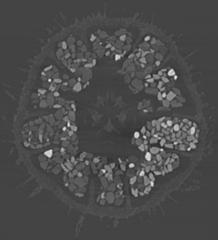Project 4915: L. G. Zachos, A. Ziegler. 2024. Selective concentration of iron, titanium, and zirconium substrate minerals within Gregoryâs diverticulum, an organ unique to derived sand dollars (Echinoidea: Scutelliformes). PeerJ. 12:e17178.
Abstract
Gregory’s diverticulum, a digestive tract structure unique to a derived group of sand dollars (Echinoidea: Scutelliformes), is filled with sand grains obtained from the substrate the animals inhabit. The simple methods of shining a bright light through a specimen or testing response to a magnet can reveal the presence of a mineral-filled diverticulum. Heavy minerals with a specific gravity of >2.9 g/cm3 are selectively concentrated inside the organ, usually at concentrations one order of magnitude, or more, greater than found in the substrate. Analyses of diverticulum content for twelve species from nine genera, using optical mineralogy, powder X-ray diffraction, scanning electron microscopy and energy dispersive X-ray spectroscopy, as well as micro-computed tomography shows the preference for selection of five major heavy minerals: magnetite (Fe3O4), hematite (Fe2O3), ilmenite (FeTiO3), rutile (TiO2), and zircon (ZrSiO4). Minor amounts of heavy or marginally heavy amphibole, pyroxene and garnet mineral grains may also be incorporated. In general, the animals exhibit a preference for mineral grains with a specific gravity of >4.0 g/cm3, although the choice is opportunistic and the actual mix of mineral species depends on the mineral composition of the substrate. The animals also select for grain size, with mineral grains generally in the range of 75 to 150 μm, and do not appear to alter this preference during ontogeny. A comparison of analytical methods demonstrates that X-ray attenuation measured using micro-computed tomography is a reliable non-destructive method for heavy mineral quantification when supported by associated analyses of mineral grains extracted destructively from specimens or from substrate collected together with the specimens. Commonalities in the electro-chemical surface properties of the ingested minerals suggest that such characteristics play an important role in the selection process.Read the article »
Article DOI: 10.7717/peerj.17178
Project DOI: 10.7934/P4915, http://dx.doi.org/10.7934/P4915
| This project contains |
|---|
Download Project SDD File |
Currently Viewing:
MorphoBank Project 4915
MorphoBank Project 4915
- Creation Date:
09 October 2023 - Publication Date:
10 March 2024 - Media downloads: 5

This research
supported by
Authors' Institutions ![]()
- University of Mississippi
- Rheinische Friedrich-Wilhelms-Universität Bonn (University of Bonn)
Members
| member name | taxa |
specimens |
media |
| Alexander Ziegler Project Administrator | 12 | 21 | 88 |
| Louis G. Zachos Full membership | 0 | 0 | 0 |
Project has no matrices defined.
Project downloads 
| type | number of downloads | Individual items downloaded (where applicable) |
| Total downloads from project | 6 | |
| Media downloads | 5 | M895000 (1 download); M894903 (1 download); M894900 (2 downloads); M894893 (1 download); |
| Project downloads | 1 |

